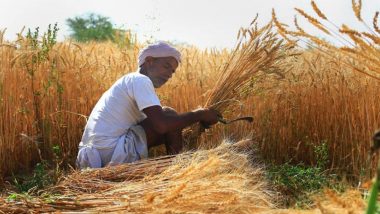The MSP or minimum support prices are guaranteed to farmers in India on 22 major crops, which includes wheat, paddy, grams and lentils. Also referred to as the base selling price, the intent behind MSP is to ensure that the farmers are guaranteed at least the minimum amount of profit on their produce. The pricing formula also prevents the market forces from solely decided the selling rate. Dushyant Chautala Says He Will Resign as Haryana Deputy CM 'The Day Farm Bills Pose Any Danger to MSP Regime'.
Amid the ongoing row over the agriculture reform Bills passed by the Narendra Modi government, the issue of MSP is at the centrestage. Agrarian bodies, despite assurances issued by the Centre, have claimed that the new legislations would empower big-ticket private purchasers and end up diluting the MSP system.
What is MSP?
Based on the recommendations of the Commission for Agricultural Costs (CACP) and Prices, the Department of Agriculture and Cooperation, Government of India, declares Minimum Support Price for 22 crops before their sowing seasons.
The idea behind MSP is to give guaranteed fair remunerative price and assured market to the farmers, and protect them from the price fluctuations and market imperfections. The guaranteed price and assured market are expected to encourage higher investment and in adoption of modern farming practices.
Further, with the globalisation resulting in freer trade in agricultural commodities, it is considered essential to protect the economic interests of farmers who may be left disadvantaged if market forces alone decide the price of crops.
Four Main Objectives of MSP Regime:
- To protect the farmers from facing undue hardship due to price fluctuation in the market and ensure price stability.
- To ensure food security at both macro and micro levels.
- To ensure fair and equitable agricultural terms of trade.
- To provide signals for markets and market led agricultural diversification.
How is MSP Calculated?
Cost of production is one of the important factors in the determination of MSPs. While recommending its price policy, the CACP considers all costs in a comprehensive manner which is based on the methodology recommended by Expert Committees from time to time. Before proceeding further, here are three terms that need to be comprehended:
- A2: This cost refers to the expenditure incurred by the farmer in buying seeds, fertilisers, pesticides, sowing and harvesting machinery, and other miscellaneous payments made by him.
- A2+FL: This refers to the sum of amount paid out by the farmer along with a value added for "family labour". Under this mechanism, the cost of farming is derived by adding A2 with family labour (FL).
- C2: Under this mechanism, the computed cost is derived by adding A2 with family labour and the rent paid on land and interest paid on owned capital.
CACP considers both A2+FL and C2 costs while recommending MSP, according to a press release issued by the government earlier this year. The Commission reckons only A2+FL cost for return, it had added. However, C2 costs are used by CACP primarily as benchmark reference costs (opportunity costs) to see if the MSPs recommended by them at least cover these costs in some of the major producing States, the Centre has further stated.
(The above story first appeared on LatestLY on Sep 23, 2020 11:46 PM IST. For more news and updates on politics, world, sports, entertainment and lifestyle, log on to our website latestly.com).













 Quickly
Quickly











